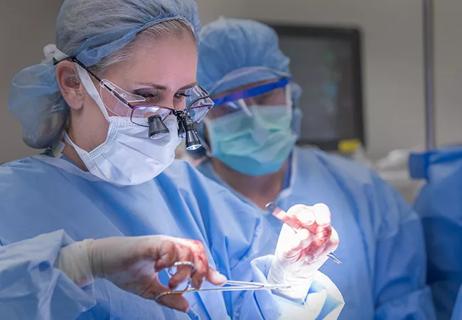After multiple modes of treatment fail, patient has rapid recovery and dramatic symptom relief from retroperitoneal bilateral adrenalectomy

By Laurence Kennedy, MD and Allan Siperstein, MD
Cleveland Clinic is a non-profit academic medical center. Advertising on our site helps support our mission. We do not endorse non-Cleveland Clinic products or services. Policy
An out-of-state patient requested a surgical consult for treatment-resistant symptoms of Cushing disease (CD). Through collaboration with her home institution, we reviewed her medical records and requested a component of her work-up take place there to minimize the burden of travel. We performed a retroperitoneal bilateral adrenalectomy without complication, and the patient was discharged to home the following morning.
The bilateral adrenalectomy is among the rarest operations performed worldwide, as the procedure has few indications. This type of case requires close interaction between medical teams—both at the home institution and the tertiary center—and the surgical team. Cleveland Clinic’s Endocrinology & Metabolism Institute is multidisciplinary by design. Together with virtual health technologies, this facilitates the multiple communications and collaborations required to manage a very complicated case like this.
CD is the consequence of chronic exposure to hypercortisolism, most commonly due to an adrenocorticotropic hormone secreting pituitary adenoma. The disease significantly impacts health-related quality of life. Symptoms can include obesity, hypertension, diabetes, cardiovascular disease, menstrual and sexual dysfunction, acne, psychiatric complications, osteoporosis, striae and proximal muscle weakness. CD is rare, with an incidence of approximately eight cases per 1,000,000 people living in the United States.
The first line of treatment is usually transsphenoidal surgery and resection of the pituitary adenoma. Remission rates with pituitary tumors are 60-90 percent for microadenomas and less than 65 percent for macroadenomas. Five years after surgery, however, the recurrence rates are 5-10 percent for microadenomas and 12-45 percent for macroadenomas. These recurrence rates continue to increase with time. When it fails or symptoms recur, second-line treatments include radiotherapy and medical treatment. After multiple failed treatment attempts, patients may be considered for bilateral adrenalectomy.
Our patient had been through a lot to relieve the symptoms of CD, including pituitary surgery, radiation and medical therapy. She was very frustrated with the manifestations of the disease, which in this case included weight gain, muscle weakness, high blood pressure, high blood sugar and anxiety. She felt relatively desperate to get definitive relief.
With the traditional transabdominal approach to bilateral adrenalectomy, the patient is positioned on one side for the first adrenal, and is then must to be turned to the other side, reprepped and redraped for the second adrenal. It is as though the patient undergoes two surgeries. The transabdominal approach also necessitates retracting the liver on the right and the spleen on the left in order to reach the adrenals.
A newer approach, the endoscopic retroperitoneal adrenalectomy was developed in Istanbul during the 1990s by Seluck Mercan, MD. I was fortunate enough to scrub in with Dr. Mercan on his eighth retroperitoneal bilateral adrenalectomy, and then brought the procedure back to the United States. This has become the preferred approach for many surgeons in bilateral adrenalectomy. We currently use the laparoscopic retroperitoneal approach whenever possible, as it requires less surgical time and smaller incisions. Its direct access to the adrenals means there is no need to shift the internal organs. Following surgery, patients eat normally and are up and walking within hours. They rarely need narcotic pain medication. These patients generally go home the morning after surgery. Essentially, the whole risk-benefit equation has shifted in this disease process.
This particular out-of-state patient wrote a letter to our ombudsman indicating just how thrilled she was with the outcome of her procedure. When she wrote, just nine days after her surgery, she indicated that she felt like a different person. Although CD itself is rarely a life-or-death situation, patients suffer with sometimes debilitating symptoms for many years, with multiple medical appointments, surgery and radiation that do not always provide definitive symptom relief. This woman was able to fly into Cleveland, have her surgery, and go home the next day. She very quickly saw dramatic symptomatic improvement. As an operative team, we are obviously thrilled that we can really give someone some tangible benefits from a procedure on a patient by patient basis. That is why we practice medicine.

Giving young patients a hand as they take charge of their own health

Case illustrates how easily condition can mimic preeclampsia

Guidance for counseling patients on the use of one of the most common daily supplements taken in the US

Understanding vitamin A toxicity and treatment

For patients with kidney disease, failure to recognize all parathyroid glands can result in failed surgery

Treating a rare eye disease with a multi-disciplinary approach

Focus on metabolic bone disease

Case report illustrates the importance of maintaining high levels of clinical suspicion